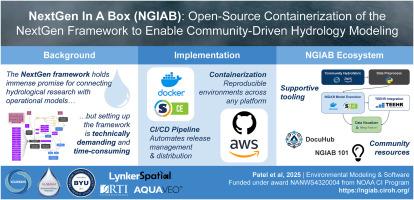NextGen In A Box (NGIAB): NextGen框架的开源容器化,可实现社区驱动的水文建模
IF 4.6
2区 环境科学与生态学
Q1 COMPUTER SCIENCE, INTERDISCIPLINARY APPLICATIONS
引用次数: 0
摘要
NextGen水资源建模框架(NextGen)极大地提高了水文建模工作流程的灵活性和互操作性。然而,由于安装过程复杂,部署下一代模型仍然具有挑战性。为了解决这个问题,我们开发了NextGen In A Box (NGIAB),这是一个NextGen框架的一体化发行版,使用Docker和Singularity容器简化了跨环境的部署。NGIAB预先配置了国家水模型4.0版本中的大多数组件,该版本将使用NextGen框架。此外,NGIAB利用基于云的持续集成/持续部署管道来自动化发布。通过其易于访问和强大的配套设施,NGIAB促进了社区参与水文建模,并促进了从研究到运营(R2O)的途径。在这项工作中,我们提出了实现这些结果的设计和技术,以及证明NGIAB适用性的研究和性能基准。本文章由计算机程序翻译,如有差异,请以英文原文为准。

NextGen In A Box (NGIAB): Open-Source containerization of the NextGen framework to enable community-driven hydrology modeling
The NextGen Water Resources Modeling Framework (NextGen) greatly increases the flexibility and interoperability of hydrologic modeling workflows. However, deploying NextGen models remains challenging due to a complex installation process. To address this, we developed NextGen In A Box (NGIAB), an all-in-one distribution of the NextGen framework that simplifies deployment across environments using Docker and Singularity containers. NGIAB comes pre-configured with most components expected in version 4.0 of the National Water Model, which will use the NextGen framework. Additionally, NGIAB utilizes a cloud-based continuous integration/continuous deployment pipeline to automate releases. Through its ease of access and robust suite of included utilities, NGIAB promotes community engagement in hydrologic modeling and facilitates research-to-operation (R2O) pathways. In this work, we present the designs and technologies that enable these outcomes, along with studies and performance benchmarks that demonstrate NGIAB's applicability.
求助全文
通过发布文献求助,成功后即可免费获取论文全文。
去求助
来源期刊

Environmental Modelling & Software
工程技术-工程:环境
CiteScore
9.30
自引率
8.20%
发文量
241
审稿时长
60 days
期刊介绍:
Environmental Modelling & Software publishes contributions, in the form of research articles, reviews and short communications, on recent advances in environmental modelling and/or software. The aim is to improve our capacity to represent, understand, predict or manage the behaviour of environmental systems at all practical scales, and to communicate those improvements to a wide scientific and professional audience.
 求助内容:
求助内容: 应助结果提醒方式:
应助结果提醒方式:


